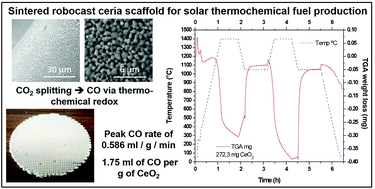Robocasting of 3D printed and sintered ceria scaffold structures with hierarchical porosity for solar thermochemical fuel production from the splitting of CO2
Abstract
We report the first ever robocast (additive manufacturing/3D printing) sintered ceria scaffolds, and explore their use for the production of renewable fuels via solar thermochemical fuel production (STFP, water and carbon dioxide splitting using concentrated solar energy). CeO2 catalyst scaffolds were fabricated as 50 mm diameter discs (struts and voids ∼500 μm), sintered at 1450 °C, with specific surface area of 1.58 m2 g−1. These scaffolds have hierarchical porosity, consisting of the macroporous scaffold structure combined with nanoscale porosity within the ceria struts, with mesopores <75 Å and an average pore size of ∼4 nm, and microporosity <2 nm with a microporous surface area of 0.29 m2 g−1. The ceria grains were ≤500 nm in diameter after sintering. STFP testing was carried out via thermogravimetric analysis (TGA) with reduction between 1050–1400 °C under argon, and oxidation at 1050 °C with 50% CO2, gave rapid CO production during oxidation, with high peak CO production rates (0.436 μmol g−1 s−1, 0.586 ml g−1 min−1), for total CO yield of 78 μmol g−1 (1.747 ml g−1). 90% CO was obtained after just 10 min of oxidation, comparing well to reticulated ceria foams, this CO production rate being an order of magnitude greater than that for ceria powders when tested at similar temperatures.

- This article is part of the themed collection: CO2 capture and conversion


 Please wait while we load your content...
Please wait while we load your content...